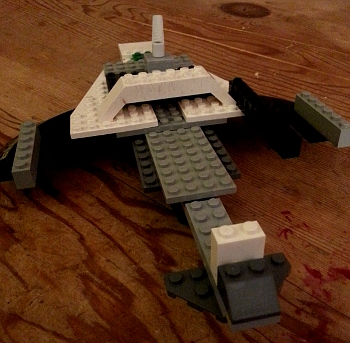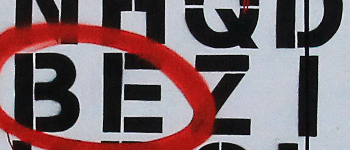 I’m primarily working on a novel at the moment, but I’m also increasingly interested in the form and structure of the short story . I’ve taken to reading and annotating stories, both literary and science fiction, to get a sense of what works and what sells — overlapping but not identical spheres.
I’m primarily working on a novel at the moment, but I’m also increasingly interested in the form and structure of the short story . I’ve taken to reading and annotating stories, both literary and science fiction, to get a sense of what works and what sells — overlapping but not identical spheres.
This week I have been reading Boojum by Elizabeth Bear and Sarah Monette, a lovely tale of pirates in space which has been much anthologised. Because this story is available online (PDF) I thought I’d share some of my notes. Read the story before reading on here.. it’s fun, and THERE WILL BE SPOILERS to come. You have been warned.
Read it? Good wasn’t it?
If you’re a regular reader you’ll know I love The Poetics. One of the things that interested me right off about Boojum was the way that the structure conformed to Aristotle’s recipe for good tragedy. Let’s check off some of the elements.
The story is self-contained. That is, although Black Alice has a past that informs the events here, the story explicitly begins at the start and ends at the end. Nothing is left out, and nothing unrelated is included.
It sometimes seems that this Aristotelian requirement is more often observed in science fiction short stories than in literary fiction shorts which can be more fragmentary and ambiguous. That’s a gross generalisation, of course. In any case a fragmentary story is not necessarily less Aristotelian. Aristotle made a distinction between a story’s underlying events and the story as portrayed. As Malcolm Heath wrote in his fantastic introduction to the Penguin Poetics,
Aristotle is often quoted as if he had said that a play has a beginning, a middle and an end. This is wrong. It is the plot, the underlying sequence of actions, that has this structure
Nevertheless, Bear and Monette manage to present a complete story in the events protrayed. Pretty good, when you consider that this means that all the worldbuilding and exposition together with a space battle, a boarding party, an orgiastic bathtime interview, a sneaky mission to the pirate hold, and the final climax must all be packed into 7500 words.
With one slight caveat, the parts of Boojum are connected in a way that is necessary or probable – that is, each part follows plausibly from the last and leads to the next. So:
The attack (leads naturally to) the boarding of the attacked ship (which leads naturally to) the discovery of the jars. (Because she loves her ship and is repulsed by the whole brain in jar thing) Black Alice warns the captain. (Because the captain callously ignores her concerns, and a little bit because plot) Black Alice sneaks into the hold and looks at the cargo, and the ship affirms its affinity with Black Alice by giving her water. (Because of this rapport between Black Alice and the ship) Black Alice frees the ship from the restraining bolt thingie, and the ship ‘eats’ Black Alice, thus rescuing her from the attacking Mi-Go.
It pretty much holds together, right? And that’s just the flow from scene to scene. As we’ll see the whole is bound together tighter still. Note that I said ‘a bit because plot‘ above. I guess that this is probably the weakest link in the causal chain. I’m not entirely sure the authors convince me of Black Alice’s motives here. She knows there are brains in those jars, and that they’re alive. It’s not clear she has much to gain by confirming this. So for the only time in the story I found myself thinking.. ‘Black Alice is doing this because the plot wants her to do it, and not because she does‘. A minor criticism, though — and a subjective take.
So what next? Well there’s a reversal of fortune for sure. Black Alice’s fate seems sealed as she stands on hull of the Lavinia Whateley waiting for brain stealing fungal things to come for her. Better still, the seeds of her rescue seem to lie in her empathy with the spaceship (though we might argue that the ship would have incorporated anyone in the crew as part of its lifecycle transition).
There is recognition. There are at least three moments of insight in the story’s climax. Firstly, Black Alice understands the nature of the restraining bolt and how that makes her complicit in an inhumane act. Secondly, she understands that the Mi-Go will punish the crew for the arrogance of their captain. Finally, she understands what it means to be ‘eaten’ by a Boojum. Does this recognition turn inward to represent a change in Black Alice’s character? Perhaps not so much. In many science fiction stories the moment of recognition (and of astonishment) are external. They reveal something fundamental about the setting, about the story world, or the principle under examination. The character is often an agent of that recognition, not its subject.
This final element provides the astonishment too, and of the best kind. Aristotle argued that astonishment should not be arbitrary. In other words the seeds for the astonishment should lie already in the story. You can’t import an astonishing twist. A twist must be astonishing and plausible at the same time. The authors lay this groundwork early on. This is from page 4: “There were stories about the Marie Curie, too.” And this passage from page 10:
They probably knew exactly what was wrong and exactly what to do to keep the Lavinia Whateley from going core meltdown like the Marie Curie had. That was a whispered story, not the sort of thing anybody talked about except in their hammocks after lights out.
The Marie Curie had eaten her own crew.
And there’s more. The Marie Curie‘s crew-eating binge beats through the story like a rising pulse. When we finally learn what this eating entails, it is an astonoshing reversal of expectation, but it is also organically part of the story.
There is identification too. Arisotle said that the audience should feel pity and fear on behalf of the hero. And should not feel disgust. We respond to Black Alice’s empathy for the ship, and for its crew, for the poor tortured brains acquired by the Mi-Go. We understand her ambition to talk to a Boojum. At each stage, her good qualities are contrasted with the those of her foil, the captain. Where she has empathy, the captain has cynicism. Where she wants to help, the captain wants to profit. It is therefore satisfying when the captain falls and Black Alice rises.
I’ve not yet finished with this story. There’s still much to learn from it. I’ll keep on studying and may return to it in a future piece.
For now though, it’s worth summing up. This is a clever story. It plays with pirate tropes without becoming a caricature. Like so many science fiction shorts it’s a puzzle piece. Its climactic reveal exposes a surprising facet of the story world. And yet Black Alice is an emotionally engaging character, and the tentative relationship between her and the Lavinia Whateley is subtly and sensitively drawn.




